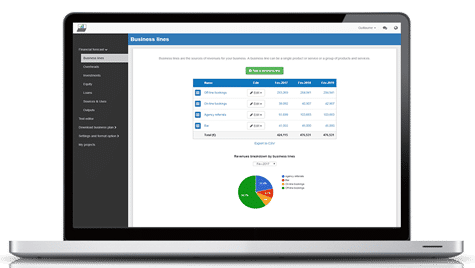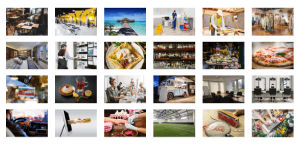How to create a financial forecast for a Portuguese restaurant?
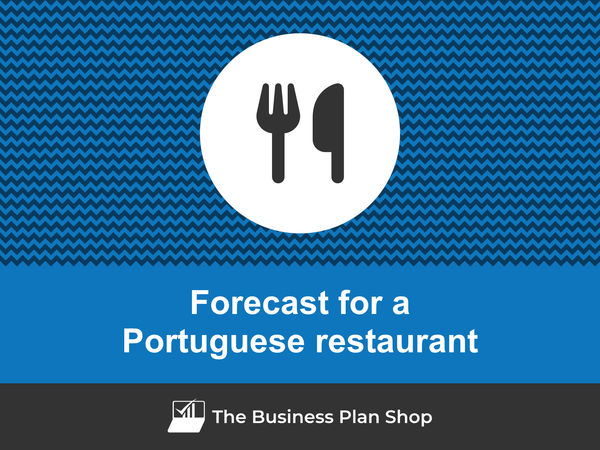
Creating a financial forecast for your Portuguese restaurant, and ensuring it stays up to date, is the only way to maintain visibility on future cash flows.
This might sound complex, but with the right guidance and tools, creating an accurate financial forecast for your Portuguese restaurant is not that hard.
In this guide, we'll cover everything from the main goal of a financial projection, the data you need as input, to the tables that compose it, and the tools that can help you build a forecast efficiently.
Without further ado, let us begin!
Why create and maintain a financial forecast for a Portuguese restaurant?
The financial projections for your Portuguese restaurant act as a financial blueprint to guide its growth with confidence and ensure its long-term financial viability.
To create them, you will need to look at your business in detail - from sales to operating costs and investments - to assess how much profit it can generate in the years to come and what will be the associated cash flows.
During challenging market conditions, maintaining an up-to-date financial forecast enables early detection of potential financial shortfalls, allowing for timely adjustments or securing financing before facing a cash crisis.
Your Portuguese restaurant's financial forecast will also prove invaluable when seeking financing. Banks and investors will undoubtedly request a thorough examination of your financial figures, making precision and presentation essential.
Need a solid financial forecast?
The Business Plan Shop does the maths for you. Simply enter your revenues, costs and investments. Click save and our online tool builds a three-way forecast for you instantly.
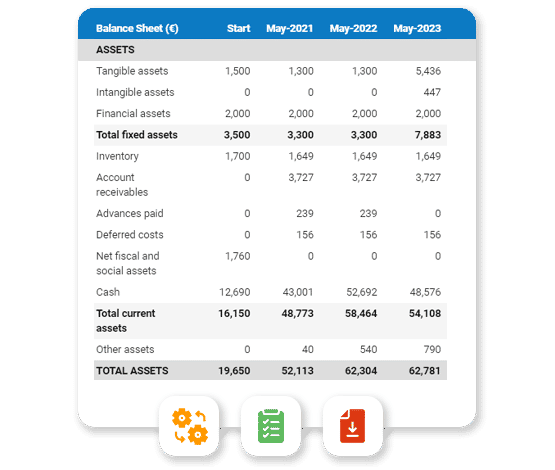
What information is used as input to build a Portuguese restaurant financial forecast?
A Portuguese restaurant's financial forecast is only as good as the inputs used to build it.
If you are creating (or updating) the forecast of an existing Portuguese restaurant, then you mostly need your accounting information, key historical operating non-financial data, and your team’s input on what to expect for the coming years.
If you are building financial projections for a Portuguese restaurant startup, you will need to have done your research and have a clear picture of your competitive environment and go-to-market strategy so that you can forecast sales accurately.
For a new venture, you will also need a precise list of the resources needed to keep the Portuguese restaurant running on a day-to-day basis and a list of the equipment and expenditures required to start the business (more on that later).
Let's now take a closer look at the elements that make up your Portuguese restaurant's financial forecast.
The sales forecast for a Portuguese restaurant
From experience, it is usually best to start creating your Portuguese restaurant financial forecast by your sales forecast.
To create an accurate sales forecast for your Portuguese restaurant, you will have to rely on the data collected in your market research, or if you're running an existing Portuguese restaurant, the historical data of the business, to estimate two key variables:
- The average price
- The number of monthly transactions
To get there, you will need to consider the following factors:
As the owner of a Portuguese restaurant, it is important to consider various factors that can affect your business's average price and number of monthly transactions. These drivers can help you create a more accurate sales forecast for the next three years. Here are five examples of drivers that you should keep in mind:
- Seasonal demand: The demand for Portuguese cuisine may vary depending on the season. For example, during the summer months, you may experience an increase in sales due to tourists and locals looking for lighter, seafood-based dishes. On the other hand, during the colder months, there may be a higher demand for hearty, warming dishes such as feijoada.
- Tourism trends: The number of tourists visiting your area can significantly impact your business. Keep an eye on tourism trends and events in your city, as they can attract more customers to your restaurant. For instance, if there is a popular Portuguese festival happening nearby, you may see an increase in sales during that time.
- Food costs: The cost of ingredients can affect your average price and ultimately, your sales. Keep track of market fluctuations and adjust your menu prices accordingly. For instance, if there is a shortage of a certain type of seafood, it may be more expensive, and you may need to adjust your menu prices to maintain your profit margins.
- Competition: The level of competition in your area can also impact your business's sales. If there are several other Portuguese restaurants nearby, you may need to adjust your prices or offer unique dishes to stand out and attract more customers. On the other hand, if you are the only Portuguese restaurant in the area, you may have more control over your prices.
- Online reviews and word-of-mouth: In today's digital age, online reviews and word-of-mouth can significantly influence a restaurant's success. Positive reviews and recommendations from satisfied customers can attract more diners and improve your average price. On the other hand, negative reviews can harm your business's reputation and lead to a decrease in sales.
Once you have an idea of what your future sales will look like, it will be time to work on your overhead budget. Let’s see what this entails.
Need inspiration for your business plan?
The Business Plan Shop has dozens of business plan templates that you can use to get a clear idea of what a complete business plan looks like.
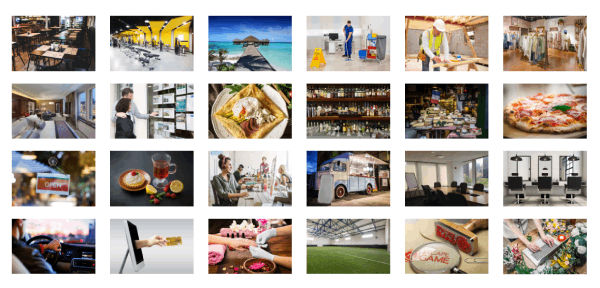
The operating expenses for a Portuguese restaurant
The next step is to estimate the costs you’ll have to incur to operate your Portuguese restaurant.
These will vary based on where your business is located, and its overall size (level of sales, personnel, etc.).
But your Portuguese restaurant's operating expenses should normally include the following items:
- Staff costs: This includes salaries, wages, and benefits for your restaurant staff, such as chefs, servers, and kitchen assistants.
- Food and beverage costs: This includes the cost of ingredients and supplies for your dishes and drinks. As a Portuguese restaurant, you may have expenses for traditional dishes like bacalhau, caldo verde, and pastéis de nata.
- Rent or lease: This expense includes the cost of renting or leasing your restaurant space. This can vary depending on the location and size of your restaurant.
- Utilities: This includes the cost of electricity, gas, water, and other utilities necessary to run your restaurant.
- Accountancy fees: You may need to hire an accountant to help you manage your finances and taxes. This expense will vary depending on the complexity of your restaurant's finances.
- Insurance costs: This includes the cost of insurance for your restaurant, such as general liability insurance, property insurance, and workers' compensation insurance.
- Marketing and advertising: This includes the cost of promoting your restaurant through various channels, such as social media, print ads, and influencer partnerships.
- Software licenses: You may need to purchase software licenses for your restaurant, such as point-of-sale systems, reservation systems, and accounting software.
- Banking fees: This includes the fees associated with your restaurant's bank accounts, such as monthly maintenance fees and transaction fees.
- Cleaning and maintenance: This includes the cost of cleaning supplies, equipment maintenance, and repairs for your restaurant.
- Waste management: This includes the cost of garbage collection and disposal for your restaurant.
- Training and development: You may need to invest in training for your staff to ensure they are knowledgeable about Portuguese cuisine and culture.
- Licenses and permits: You may need to obtain licenses and permits to operate your restaurant, such as a food service license and liquor license.
- Credit card fees: If you accept credit card payments, you will have to pay processing fees for each transaction.
- Taxes: As a business owner, you will have to pay various taxes, such as income tax, sales tax, and payroll taxes.
This list is not exhaustive by any means, and will need to be tailored to your Portuguese restaurant's specific circumstances.
What investments are needed to start or grow a Portuguese restaurant?
Your Portuguese restaurant financial forecast will also need to include the capital expenditures (aka investments in plain English) and initial working capital items required for the creation or development of your business.
For a Portuguese restaurant, these could include:
- Kitchen Equipment: As a Portuguese restaurant, you will need specialized kitchen equipment to prepare traditional dishes such as a wood-fired oven for baking bread and grilling meats, a paella pan for making seafood dishes, and a traditional clay pot for slow-cooked stews. These equipment can be expensive, but they are essential for maintaining the authenticity of your menu.
- Furniture and Decor: Creating a cozy and inviting atmosphere is important for a Portuguese restaurant. This may require investing in high-quality furniture such as wooden tables and chairs, traditional Portuguese tiles for decoration, and unique lighting fixtures. These elements will contribute to the overall ambiance of your restaurant and enhance the dining experience for your customers.
- Point of Sale System: A modern and efficient point of sale (POS) system is essential for any restaurant, including Portuguese ones. This system will help you manage orders, track inventory, and process payments seamlessly. It may also include features such as online ordering and reservation management, which can improve your restaurant's efficiency and customer service.
- Wine Cellar: As Portugal is known for its excellent wines, having a well-stocked wine cellar is crucial for a Portuguese restaurant. This may require investing in a temperature-controlled wine storage system, wine racks, and wine glasses. Offering a variety of Portuguese wines will not only complement your menu but also attract wine enthusiasts to your restaurant.
- Outdoor Seating: If your restaurant has an outdoor space, consider investing in outdoor furniture and heaters to extend your seating capacity. This will allow you to accommodate more customers during peak seasons and provide a unique dining experience for your guests. You may also need to invest in outdoor lighting and decorations to create an inviting atmosphere for your outdoor seating area.
Again, this list will need to be adjusted according to the size and ambitions of your Portuguese restaurant.
Need a convincing business plan?
The Business Plan Shop makes it easy to create a financial forecast to assess the potential profitability of your projects, and write a business plan that’ll wow investors.
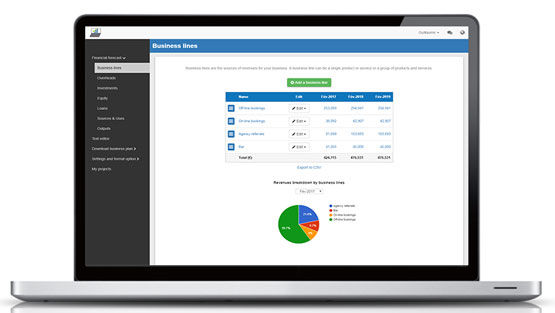
The financing plan of your Portuguese restaurant
The next step in the creation of your financial forecast for your Portuguese restaurant is to think about how you might finance your business.
You will have to assess how much capital will come from shareholders (equity) and how much can be secured through banks.
Bank loans will have to be modelled so that you can separate the interest expenses from the repayments of principal, and include all this data in your forecast.
Issuing share capital and obtaining a bank loan are two of the most common ways that entrepreneurs finance their businesses.
What tables compose the financial plan for a Portuguese restaurant?
Now let's have a look at the main output tables of your Portuguese restaurant's financial forecast.
The projected profit & loss statement
The projected profit & loss shows how profitable your Portuguese restaurant is likely to be in the years to come.
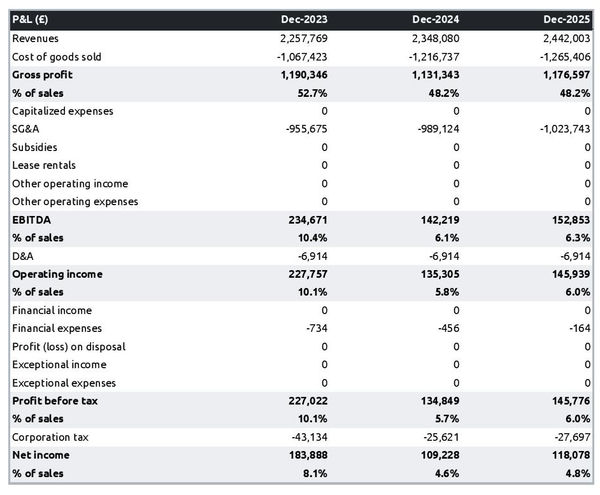
For your Portuguese restaurant to be financially viable, your projected P&L should ideally show:
- Sales growing above inflation (the higher the better)
- Profit margins which are stable or expanding (the higher the better)
- A net profit at the end of each financial year (the higher the better)
This is for established Portuguese restaurants, there is some leniency for startups which will have numbers that will look a bit different than existing businesses.
The projected balance sheet
The projected balance sheet gives an overview of your Portuguese restaurant's financial structure at the end of the financial year.
It is composed of three categories of items: assets, liabilities and equity:
- Assets: are what the business possesses and uses to produce cash flows. It includes resources such as cash, buildings, equipment, and accounts receivable (money owed by clients).
- Liabilities: are the debts of your Portuguese restaurant. They include accounts payable (money owed to suppliers), taxes due and bank loans.
- Equity: is the combination of what has been invested by the business owners and the cumulative profits to date (which are called retained earnings). Equity is a proxy for the value of the owner's stake in the business.

The cash flow projection
The cash flow forecast of your Portuguese restaurant will show how much cash the business is expected to generate or consume over the next three to five years.
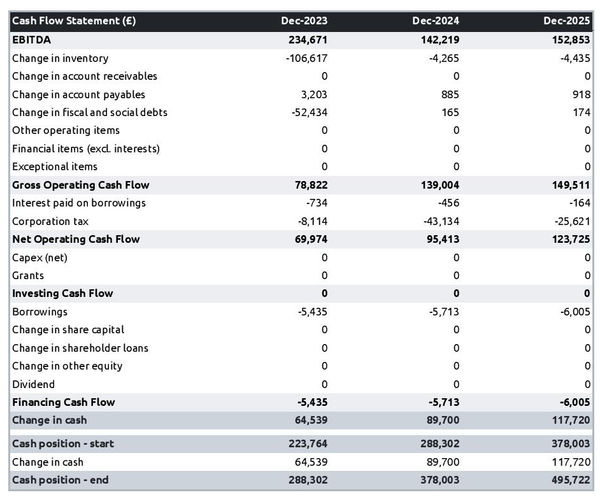
There are multiple ways of presenting a cash flow forecast but from experience, it is better to organise it by nature in order to clearly show these elements:
- Operating cash flow: how much cash is generated by the Portuguese restaurant's operations
- Investing cash flow: what is the business investing to expand or maintain its equipment
- Financing cash flow: is the business raising additional funds or repaying financiers (debt repayment, dividends)
Your cash flow forecast is the most important element of your overall financial projection and that’s where you should focus your attention to ensure that your Portuguese restaurant is adequately funded.
Note: if you are preparing a financial forecast in order to try to secure funding, you will need to include both a yearly and monthly cash flow forecast in your Portuguese restaurant's financial plan.
Need a solid financial forecast?
The Business Plan Shop does the maths for you. Simply enter your revenues, costs and investments. Click save and our online tool builds a three-way forecast for you instantly.

Which tool should you use to create your Portuguese restaurant's financial projections?
Building a Portuguese restaurant financial forecast is not difficult provided that you use the right tool for the job. Let’s see what options are available below.
Using online financial forecasting software to build your Portuguese restaurant's projections
The modern and easiest way is to use an online financial forecasting tool such as the one we offer at The Business Plan Shop.
There are several advantages to using specialised software:
- You can easily create your financial forecast by letting the software take care of the financial calculations for you without errors
- You have access to complete financial forecast templates
- You get a complete financial forecast ready to be sent to your bank or investors
- You can easily track your actual financial performance against your financial forecast, and recalibrate your forecast as the year goes by
- You can create scenarios to stress test your forecast's main assumptions
- You can easily update your forecast as time goes by to maintain visibility on future cash flows
- You have a friendly support team on standby to assist you when you are stuck
- It’s cost-efficient and much cheaper than using an accountant or consultant (see below)
If you are interested in this type of solution, you can try our projection software for free by signing up here.
Calling in a financial consultant or chartered accountant
Enlisting the help of a consultant or accountant is also a good way to obtain a professional Portuguese restaurant financial forecast.
The downside of this solution is its cost. From experience, obtaining a simple financial forecast over three years (including a balance sheet, income statement, and cash flow statement) is likely to cost a minimum of £700 or $1,000.
The indicative cost above, is for a small business, and a forecast is done as a one-shot exercise. Using a consultant or accountant to track your actuals vs. forecast and to keep your financial projections up to date on a monthly or quarterly basis will cost a lot more.
If you opt for this solution, make sure your accountant has in-depth knowledge of your industry, so that they may challenge your figures and offer insights (as opposed to just taking your assumptions at face value to create the forecast).
Why not use a spreadsheet such as Excel or Google Sheets to build your Portuguese restaurant's financial forecast?
Creating an accurate and error-free Portuguese restaurant financial forecast with a spreadsheet is very technical and requires a deep knowledge of accounting and an understanding of financial modelling.
Very few business owners are financially savvy enough to be able to build a forecast themselves on Excel without making mistakes.
Lenders and investors know this, which is why forecasts created on Excel by the business owner are often frowned upon.
Having numbers one can trust is key when it comes to financial forecasting and to that end using software is much safer.
Using financial forecasting software is also faster than using a spreadsheet, and, with the rise of artificial intelligence, software is also becoming smarter at helping us analyse the numbers to make smarter decisions.
Finally, like everything with spreadsheets, tracking actuals vs. forecasts and keeping your projections up to date as the year progresses is manual, tedious, and error-prone. Whereas financial projection software like The Business Plan Shop is built for this.
Need a convincing business plan?
The Business Plan Shop makes it easy to create a financial forecast to assess the potential profitability of your projects, and write a business plan that’ll wow investors.

Use our financial projection templates for inspiration
The Business Plan Shop has dozens of financial forecasting templates available.
Our examples contain both the financial forecast, and a written business plan which presents, in detail, the company, the team, the strategy, and the medium-term objectives.
Whether you are just starting out or already have your own Portuguese restaurant, looking at our template is always a good way to get ideas on how to model financial items and what to write when creating a business plan to secure funding.

Takeaways
- Having a financial forecast enables you to visualise the expected growth, profitability, and cash generation for your business over the next three to five years.
- Tracking actuals vs. forecast and keeping your financial projections up-to-date is the only way to get a view on what your Portuguese restaurant future cash flows may look like.
- Using financial forecasting software is the mordern and easy way to create and maintain your forecasts.
This is the end of our guide on how to build the financial forecast for a Portuguese restaurant, we hope you found it useful. Don't hesitate to contact us if you want to share your feedback or have any questions.
Need inspiration for your business plan?
The Business Plan Shop has dozens of business plan templates that you can use to get a clear idea of what a complete business plan looks like.

Also on The Business Plan Shop
Know someone who owns or is thinking of starting a Portuguese restaurant? Share our forecasting guide with them!

